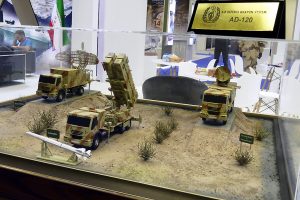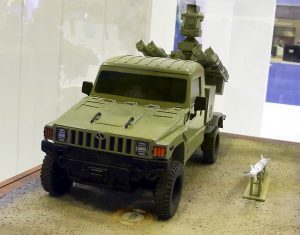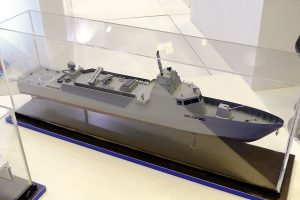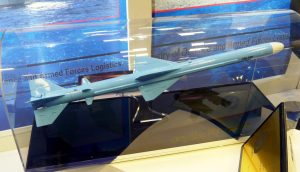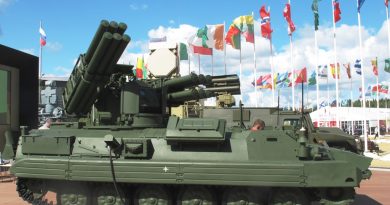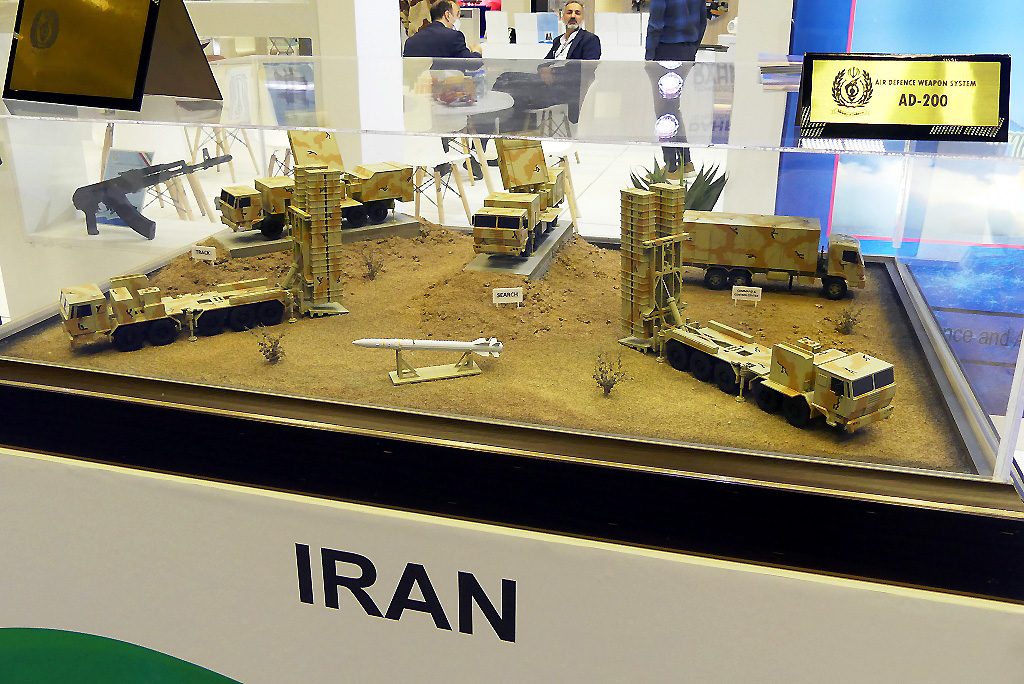
The Iranian Defence Industry unveils new air defence, anti-ship systems and naval platform
During DIMDEX 2022 the Iranian Ministry of Defence and Armed Forces Logistics presented a range of products, from the new AD-200 long-range air defence surface-to-air missile system to the new multi-mission corvette, passing through medium and short range air defence systems alongside the family of anti-ship missiles and naval weapon guns. Not immediately present at the show, but available with a complete stand which was put together in the following hours, the Iranian Defence Industry was showing its products after a long absence from international events.
The Iranian MoD presented for the first time a diorama with a scaled model of a complete battery of the locally-developed and produced AD-200 long-range air defence surface-to-air missile system. Unveiled for the first time last January in the Iranian MoD’s export catalogue, the AD-200 is reported by local sources as being the export version of the Bavar 373 long-range missile air defence system which was first unveiled in August 2019 and which was successfully fired in the Modafean Aseman Velayat 99 joint air defence exercise by Iranian armed forces in October 2020.
According to the scale model and documentation obtained by EDR On-Line, the AD-200 is a long-range air defence missile system, capable to operate in all weather conditions and to intercept advanced tactical and strategic aircraft, UAVs, cruise missiles, early warning platforms and helicopters. The AD-200 battery, based on 8×8 or 10×10 high-mobility vehicles, includes a combat control post (AD-200 CC), a phased array search radar unit (AD-200 SR) alongside a phased array tracking radar unit (AD-200 TR) and up to six transporter erector launchers (AD-200 L) each with four canisters.
The AD-200 missile is a new and more capable munition compared to the AD-120 version, also displayed at DIMDEX 2022 and in service in a domestic version according to the images of firings during the latest Iranian armed forces air defence exercises. The new missile, which resembles the latest munition of the Bavar 373 air defence system, also called as Sayyad-4, features a larger airframe with a 515 mm diameter, compared to the 400 mm of the AD-120, and a new rear control section with new control surfaces and thrust vectoring control, allowing for higher maneuverability and a shorter minimum range of 5 km compared to 7 km of the AD-120. The 7.5 meters long (vs 6.1 meters of the AD-120) and 2,050 kg (vs 995 kg for the AD-120) missile is vertically hot-launched from the canister (instead of oblique launching) and has a 200 km effective range (vs 120 km of the AD-120) and a 200 meters to 27 km altitude coverage. The AD-200 munition is equipped with a 180 kg (vs 90 kg of the AD-120) warhead with impact and proximity fuse and a guidance system centered on inertial plus update via data link and a seeker-aided ground guidance/track-via-missile terminal guidance.
The surveillance radar is based on a phased array, some sources indicating as active electronically scanned (AESA), rotating antenna providing respectively a 360 degrees in azimuth and a -3/+85 degrees coverage in elevation, has a range of 320 km and is capable to process up to 200 targets simultaneously. The target tracking phased array has a -45/+45 degrees in azimuth and a -3/+85 degrees in elevation coverage, a maximum range of 260 km and is capable to engage up to six targets with 12 missiles simultaneously.
In addition to the missile weapon system, the ADS 120 air defence missile system battery differs for the tracker and illuminator radar systems which use conventional antennas with a range up to 180 km and capable to simultaneously process only one target. The Iranian defence industry was also showing the tactical and shorter range AD-08 Majid air defence system based on a 4×4 vehicle carrying a launcher with four missile canisters and an EO/IR fire control system. The 75 kg heavy missile system is equipped with a passive imaging infrared sensor with a range from 700 meters to 8 km and altitude from 20 meters to 6 km.
A new corvette design
Together with export models of the current design of locally-built naval platforms, the Iranian Defence industry was also showing a model of the recently unveiled design for a new corvette of around 80 meters with stealth features, characterized by an important weapon package and more interestingly a sensors suite based on a new unidentified main naval phased array radar. The model features a single superstructures block with stern helicopter platform and two shaft lines of an unidentified propulsion system without funnels, indicating a potential combustion engines exhaust system horizontally on the waterline or below it. The new combatant platform features a single integrated mast accommodating a the main radar with fixed faces and flat superstructures accommodating a range of weapon systems and sensor. The corvette is armed with a bow-mounted locally-built 76/62 mm Fadjr 27 gun with a stealth shield together with an amidship vertical launching system with 8 cells for presumably surface-to-air missiles alongside two twin launchers for what are expected to be anti-ship missiles, and two locally built Kamand 30 mm close-in weapon systems. Between these two guns we find a fire control system; it is unclear to which weapon system it is related. Decoy launchers are installed in different ship locations, in addition to machine gun stations on both side of the superstructures.
The CM family of anti-ship missile
The Iranian defence industry was also showing the CM anti-ship missiles family for shipborne, coastal defence and airborne applications, which includes CM-300, CM-200, CM-90 and CM-35 missiles. Export models from the Noor, Ghader and Ghadir locally-developed derivatives of the C802 anti-ship cruise missile, the CM-300 is the more capable weapon system with a 300 km range while the CM-200, CM-90 and CM-35 reach respectively 200, 90 and 35 km. The CM-300 missile is 6.84 meters long with a 360 mm diameter, weighs 770 kg, and has a propulsion package including a solid booster and a turbojet, the latter providing a 0.8-0.9 Mach maximum speed, while guidance is provided by an inertial mid-course and a terminal active radar. The coastal battery version is composed of up to three missile launchers and a radar and command vehicle equipped with a 320 km range X-band radar. The CM-200 differs for a slightly shorter and lighter munition and the same radar and command vehicle while both versions can engage targets with a maximum speed of less than 30 knots. The active radar seeker-guided CM-90 model is 4.16 meters long with a 280 mm diameter and is equipped with a turbojet, for a total weight of 351 kg, while the smaller CM-35 can be launched by a commercial van also equipped with a small surveillance radar.
Photos by L. Peruzzi


